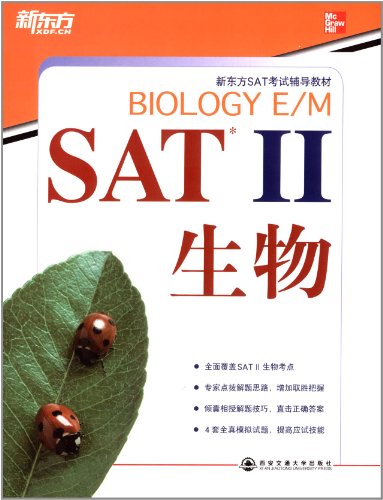9787560545202 (1 results)
Product Type
- All Product Types
- Books (1)
- Magazines & Periodicals
- Comics
- Sheet Music
- Art, Prints & Posters
- Photographs
- Maps
-
Manuscripts &
Paper Collectibles
Condition
- All Conditions
- New
- Used
Binding
- All Bindings
- Hardcover
- Softcover
Collectible Attributes
- First Edition
- Signed
- Dust Jacket
- Seller-Supplied Images
- Not Printed On Demand
Seller Location
Seller Rating
-
New Oriental SAT2: biological(Chinese Edition)
ISBN 10: 7560545203ISBN 13: 9787560545202
Seller: liu xing, Nanjing JiangSu, JS, China
Book
paperback. Condition: New. Ship out in 2 business day, And Fast shipping, Free Tracking number will be provided after the shipment.Paperback. Pub Date: 2012 Pages: 352 Language: English in Publisher: Xi'an Jiaotong University Press. New Oriental SAT exam resource materials. SAT2: biological from the United States McGraw - Hill Publishing Company exclusive introduction by New Oriental. pro forma SAT biological the authoritative resource materials. New Oriental SAT exam resource materials SAT2: biological not only cover the whole range of SAT biological test center. and provide 4 sets full simulation of questions for the candidates self-test. In addition. a detailed analysis of the book on all topics. to facilitate the candidates to recognize their own strengths and weaknesses. scientific pro forma. Contents: PART I: ABOUT THE SAT BIOLOGY EM TESTChapter 1: What You Need to Know About the SAT Biology EM Test The SAT Subject TestsThe SAT Biology EM TestTaking the TestChapter 2: How to Use This BookStudying Smart for the SAT Subject TestsDeciding between Biology- E and Biology-MChapter 3: Smart Tips for the SAT Biology EM Test Preparing for the TestThe Home StretchDuring the TestAfter the TestChapter 4: Diagnostic TestAnswer Sheet for the Diagnostic TestDiagnostic TestScore SheetAnswer KeyAnswers and ExplanationsChapter 5: Test-Taking Skills and StrategiesGeneral Test-Taking StrategiesQuestion Type 1: The Matching GameQuestion Type 2: The Numbered DiagramQuestion Type 3: The DirectQuestionQuestion Type 4: The Pick the 'Wrong' Answer Question (AKALeastExceptNot Questions) Question Type 5: Easy as I. II. IIIQuestionType 6: The Laboratory QuestionPART II: REVIEW OF BIOLOGY TOPICS Chapter 6: Understanding Molecular and Cellular Biology Lesson 6-1. Molecular BiologyVocabularyElements. Compounds. and BondsThe Elements of LifeWater. Water. EverywhereThe Role of CarbonCarbohydrates and theDehydration ReactionAmino Acids. Proteins. and Peptide BondsNucleotides and Nucleic AcidsLipids and PhospholipidsLessonSummaryReview QuestionsAnswersLesson 6-2. CellsVocabularyCharacteristics of CellsFeatures of Eukaryotic CellsCellMemanes and Cell WallsCellular TransportPlant and Animal CellsLesson SummaryReview QuestionsAnswersLesson 6-3. Energy in the Cell: Enzymes. Respiration. and PhotosynthesisVocabularyEnzymes and Energy CarriersRespirationFermentationPhotosynthesisLesson SummaryReview QuestionsAnswersLesson 6-4. DNA. RNA. ProteinVocabularyCopying DNADNA to mRNAMRNA to PolypeptideMutationsLesson SummaryReview QuestionsAnswersLesson 6-5. Mitosis and MeiosisVocabularyThe Cell CycleMitosisMeiosisLesson SummaryReviewQuestionsAnswersChapter 7: Understanding GeneticsLesson 7-1. Mendelian InheritanceVocabularyMendel: Patterns of InheritanceLesson SummaryReviewQuestionsAnswersLesson 7-2. The Genetic Bases of InheritanceVocabularyDNA: The Genetic MaterialMendel and MoleculesChromosomal AberrationsGenetic TechnologyLesson SummaryReview QuestionsAnswersLesson 7-3. Beyond Simple InheritanceVocabularySex Genes and Sex-Linked GenesPolygenic InheritanceExtra-Nuclear GenesBeyond DNALesson SummaryReview QuestionsAnswersLesson 7-4. Using Punnett SquaresVocabularyA Quick Review of ProbabilityMaking a Punnett SquareModeling InheritanceLesson SummaryReview QuestionsAnswersLesson 7-5. Using PedigreesReading a PedigreeInterpreting from a PedigreeLesson SummaryReview QuestionsAnswersChapter 8: Understanding Evolution and DiversityLesson 8-1. Evolution and Natural SelectionVocabularyDarwin and Natural SelectionEvidence for EvolutionLessonSummaryReview QuestionsAnswersLesson 8-2. Mechanisms of EvolutionVocabularyEvolution in a PopulationCreating Diversity: SpeciationLesson SummaryReview QuestionsAnswersLesson 8-3. Origins of DiversityVocabularyCreating CellsAfter CellsClassifying LifeLesson SummaryReview QuestionsAnswersLesson 8 - 4. The Three Domains and the Five KingdomsVocabularyKingdom MoneraKingdom ProtistaKingdom FungiKingdom PlantaeKingdom AnimaliaLesson SummaryReview QuestionsAnswersChapter 9.


